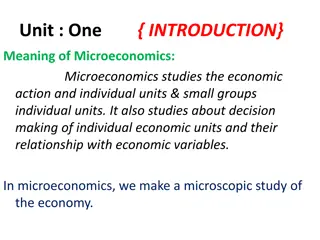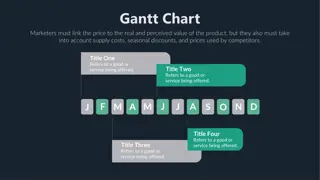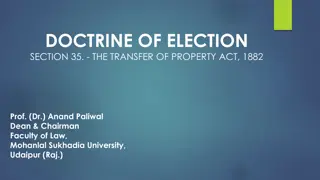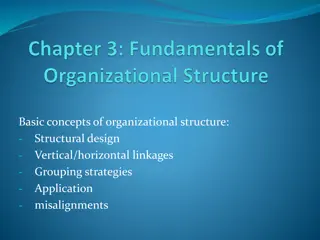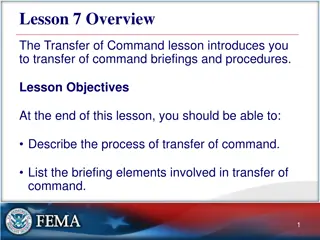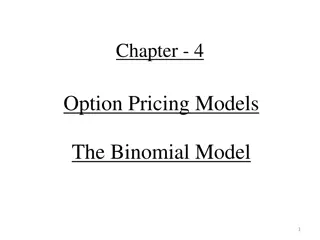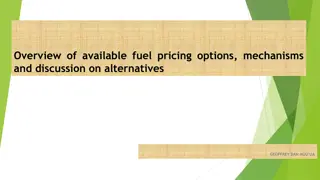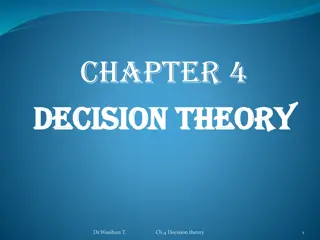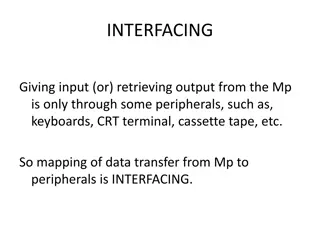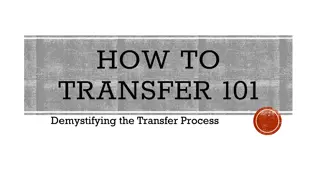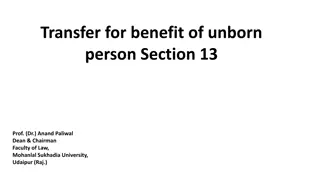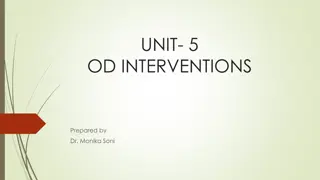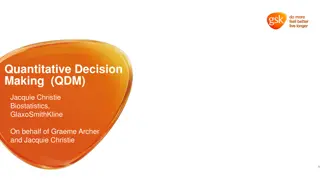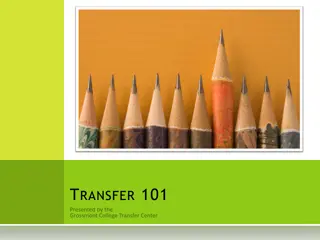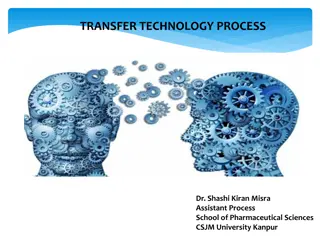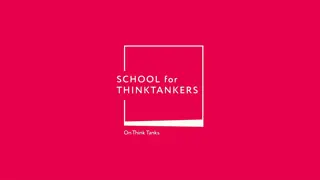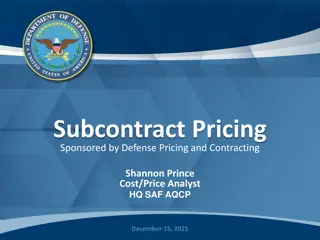Understanding Transfer Pricing in Organizational Decision Making
Explore the concept of transfer pricing in organizational decision-making, including factors affecting transfer prices, objectives of transfer pricing, and how it influences the autonomy and profitability of responsibility centers. Learn about different bases for setting transfer prices and examples illustrating budgeted annual profits under varying transfer prices.
- Transfer Pricing
- Decision Making
- Organizational Performance
- Responsibility Centers
- Internal Competition
Download Presentation

Please find below an Image/Link to download the presentation.
The content on the website is provided AS IS for your information and personal use only. It may not be sold, licensed, or shared on other websites without obtaining consent from the author. Download presentation by click this link. If you encounter any issues during the download, it is possible that the publisher has removed the file from their server.
E N D
Presentation Transcript
10 Chapter Transfer Pricing
Transfer Pricing Learning Outcome Lead C3: Analyse the performance of responsibility centres and prepare reports Component C3): Explain: a) Behavioural issues b) Use and ethics of transfer pricing Internal Competition & Internal trading. Transfer pricing for intermediate goods where market exist & where no market exist. Types of transfer prices & when to use them. Effect of transfer pricing on autonomy, & motivation of managers of responsibility centre. Effect of transfer pricing on responsibility centre & group profitability.
Chapter Content Transfer Pricing Decision Making Performance Evaluation
Objectives of Transfer Pricing Goal congruence Performance measurement Maintaining divisional autonomy Minimising global tax liability Recording the movement of goods and services Fair allocation of profits between divisions
Bases for setting transfer prices 1. Market based 2. Cost based 3. Negotiated
Selecting a transfer price If there is an external market the market price will be the ideal price (less any selling expenses) If there is no external market then - the selling division should accept a minimum price of marginal cost plus any opportunity cost. - the buying division should accept any transfer price which will allow contribution to be made (positive net marginal revenue) - there may be a range of acceptable prices which will be subject to negotiation
Example 1 A company has two profit centres, Centre A and Centre B. Centre A supplies Centre B with a part-finished product. Centre B completes the production and sells the finished units in the market at $35 per unit. Budgeted data for the year: Division A Division B Number of units transferred/sold Materials costs Other variable costs Annual Fixed Costs 10,000 $8 per unit $2 per unit $2 per unit $60,000 $30,000 10,000 $3 per unit Required: Calculate the budgeted annual profit of each profit centre and the organisation as a whole if the transfer price for components supplied by Division A to Division B is: 1. $20 2. $25
Decision Making The general rule for decision-making is that all goods and services should be transferred at opportunity cost There are 3 possible situations 1. Where there is a perfectly competitive market for an intermediate product OPTIMUM TP (DM) = MARKET PRICE + ANY SMALL ADJUSTMENTS 2. Where there is surplus capacity OPTIMUM TP (DM) = MARGINAL COST 3. Where there are production constraints OPTIMUM TP (DM) = MARGINAL COST + SHADOW PRICE
Example 2 AB Ltd has two Divisions A and B. Division A manufactures a product called the aye and Division B manufactures a product called the bee. Each bee uses a single aye as a component. A is the only manufacturer of the aye and supplies both B and outside customers. Details of A s and B s operations for the coming period are as follows: Fixed Costs Variable Costs per unit Capacity Units $7,500,000 $18,000,000 $280 30,000 Division A Division B $590 (*) 18,000 * Note: exclude transfer costs Market research has indicated that demand for AB Ltd s products from outside customers will be as follows in the coming period: the aye: at unit price $1,000 no ayes will be demanded but demand will increase by 25 ayes with every $1 that the unit price is reduced below $1,000 the bee: at unit price $4,000 no bees will be demanded, but demand will increase by 10 bees with every $1 that the unit price is reduced below $4,000
Example 2 ( Cont.) Required: a) Calculate the unit selling price of the bee (accurate to the nearest $) that will maximise AB Ltd s profit in the coming period. b) Calculate the unit selling price of the bee (accurate to the nearest $) that is likely to emerge if the Divisional Managers of A and B both set selling prices calculated to maximise Divisional profit from sales to outside customers and the transfer price of ayes going from A to B is set at market selling price . c) Explain why your answers to parts (a) and (b) are different, and propose changes to the system of transfer pricing in order to ensure that AB Ltd is charging its customers at optimum prices.
Decision Making 2. Where there is surplus capacity OPTIMUM TP (DM) = MARGINAL COST Possible Solutions - 2 part tariff The transfer price is marginal cost, but in addition a fixed sum is paid per annum or per period to the supplying division to go at least part of the way towards covering its fixed costs, and possibly even to generate a profit. - Cost-plus pricing The transfer price is the marginal cost or full cost plus a markup. - Dual pricing Dual pricing is where one transfer price is recorded by the supplying division and a different transfer price is recorded by the buying division.
Decision Making 3. Where there are production constraints OPTIMUM TP (DM) = MARGINAL COST + SHADOW PRICE There are 2 possibilities: (i) Where internal demand has to be met by foregoing external sales of another product, the shadow prices reflect contribution foregone on that other product. The resulting TP (DM) is also suitable for performance evaluation. (ii) Where the supplying division makes only one product which is only sold internally, the shadow price must now reflect contribution from the final production. The TP (DM) builds that contribution into the supplying division's revenue. Therefore all contribution will appear in the supplying division's books (and none in the buying division's). The problem is that the optimum TP (DM) is unfair to the buying division.
Example 3 Pool Group has two divisions that operate as profit centres. Each centre sells similar products, but to different segments of the market: Division P makes product P29 which it sells to external customers for $150. Variable costs of production are $45 per unit. The maximum annual sales demand for P29 is 5,000 units, although Division P has capacity for 7,000 units. Increasing output from 5,000 to 7,000 each year would result in additional fixed cost expenditure of $8,000. The manager of Division L has seen an opportunity to sell an amended version of Product P29 to its own customers, and is interested in buying 2,000 units each year to resell externally at $90 per unit. The costs of amending Product P29, for sale as Product L77, would be $25 per unit. However, the manager of Division L will not pay more than $40 per unit of Product P29. He argues that Division P will benefit from lower fixed costs per unit by working at full capacity. The manager of Division P refuses to sell at a price that does not cover the division s incremental costs. Required: Suggest a dual transfer pricing arrangement that might overcome the disagreement between the two divisional managers.






